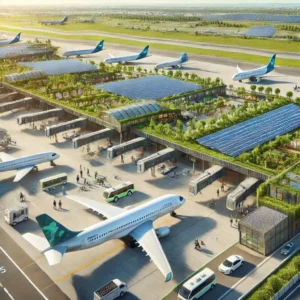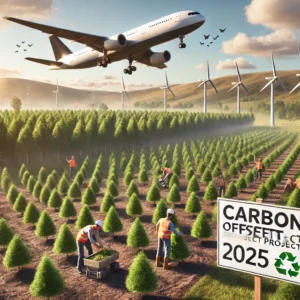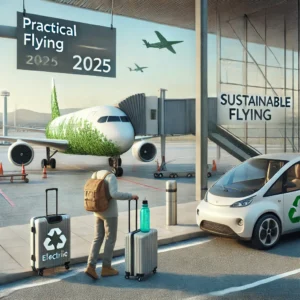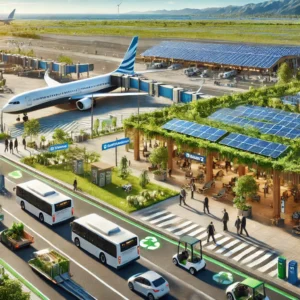Sustainable air travel is becoming increasingly vital as the aviation industry grapples with its environmental impact. In 2025, the global focus on reducing carbon emissions has pushed airlines and airports across the United States to innovate. With air travel contributing approximately 2-3% of global CO2 emissions, the need for sustainable alternatives is critical. Travelers are seeking ways to minimize their environmental footprint without sacrificing the convenience of flying.
This guide will outline how U.S. air travel is evolving, what airlines and airports are leading the way, and actionable steps travelers can take to reduce their carbon footprint while flying in 2025.
The State of Air Travel Sustainability in 2025
 In 2025, air travel sustainability is no longer an option but a necessity. The International Air Transport Association (IATA) has set ambitious targets, including achieving net-zero carbon emissions by 2050. Airlines in the U.S. are at the forefront of this change, investing heavily in technologies and practices aimed at reducing their environmental impact.
In 2025, air travel sustainability is no longer an option but a necessity. The International Air Transport Association (IATA) has set ambitious targets, including achieving net-zero carbon emissions by 2050. Airlines in the U.S. are at the forefront of this change, investing heavily in technologies and practices aimed at reducing their environmental impact.
Key Innovations
- Sustainable Aviation Fuel (SAF): SAF is one of the most significant advancements in reducing the carbon footprint of air travel. In 2025, many U.S. airlines, including Delta and United, are using SAF blended with conventional jet fuel. SAF can reduce lifecycle carbon emissions by up to 80% compared to traditional fuels.
- Electric and Hybrid Aircraft: Although still in the early stages, electric aircraft are expected to revolutionize short-haul flights. Companies like Wright Electric and Airbus are developing electric planes, with the first commercial flights expected by the end of the decade. In 2025, these advancements continue to push the industry toward greener alternatives.
- Efficiency Improvements: Modern aircraft are becoming more fuel-efficient through lighter materials and improved aerodynamics. The Boeing 787 Dreamliner, for instance, consumes 20-25% less fuel than older models, making it a popular choice for airlines looking to cut emissions.
Eco-Friendly Airlines to Choose in the U.S. in 2025
 Choosing the right airline is one of the most impactful ways travelers can reduce their carbon footprint. In 2025, several U.S. airlines stand out for their commitment to sustainability:
Choosing the right airline is one of the most impactful ways travelers can reduce their carbon footprint. In 2025, several U.S. airlines stand out for their commitment to sustainability:
Delta Air Lines
Delta has pledged to become the first carbon-neutral airline globally. They invest in SAF, carbon offset programs, and fleet modernization to reduce emissions. Delta’s Carbon Council ensures continuous improvement in environmental impact through innovative practices.
JetBlue
JetBlue became the first U.S. airline to achieve carbon neutrality for all domestic flights in 2020 and has continued to expand these efforts. By 2025, they’ve increased their use of SAF, improved fuel efficiency, and introduced a comprehensive carbon offset program for international flights.
Alaska Airlines
Alaska Airlines has made significant strides in reducing its environmental footprint by investing in more fuel-efficient aircraft and SAF. Their LIFT initiative focuses on innovation, aiming to cut carbon emissions by 50% by 2040.
For travelers prioritizing sustainability, choosing these airlines can significantly reduce the impact of their flights.
Carbon Offsetting: How to Offset Your Flight’s Emissions in 2025
 While choosing eco-friendly airlines is crucial, carbon offsetting allows travelers to neutralize the emissions produced during their flights. In 2025, most major U.S. airlines offer carbon offset programs directly through their booking platforms.
While choosing eco-friendly airlines is crucial, carbon offsetting allows travelers to neutralize the emissions produced during their flights. In 2025, most major U.S. airlines offer carbon offset programs directly through their booking platforms.
How Does Carbon Offsetting Work?
When you offset your flight, you contribute to projects that reduce or capture carbon emissions, such as:
- Reforestation projects: Planting trees to absorb CO2.
- Renewable energy projects: Investing in solar, wind, and hydroelectric power.
- Methane capture: Reducing emissions from landfills or livestock farms.
The cost to offset a typical round-trip flight in the U.S. is modest—approximately $10-30 for domestic flights, depending on the distance. These funds support verified carbon offset projects. Websites like Cool Effect and Gold Standard allow travelers to purchase offsets independently if not offered by their airline.
According to a 2023 study by McKinsey & Company, carbon offsetting could mitigate up to 40% of the aviation industry’s emissions by 2030, making it a crucial tool for sustainable air travel.
Practical Tips for Sustainable Flying in 2025
 Sustainable flying doesn’t end with booking a greener flight. Here are practical steps every traveler can take to minimize their environmental impact while flying in 2025.
Sustainable flying doesn’t end with booking a greener flight. Here are practical steps every traveler can take to minimize their environmental impact while flying in 2025.
Pack Light
The weight of luggage directly impacts fuel consumption. Lighter planes consume less fuel, meaning travelers can reduce emissions by packing only what they need. Even shedding 10 pounds of luggage can lead to notable reductions in emissions across millions of passengers.
Opt for Direct Flights
Flying direct reduces emissions since takeoffs and landings are responsible for a large portion of a flight’s carbon output. Whenever possible, choose non-stop flights to lower your environmental impact.
Bring Your Own Reusables
Reduce waste by bringing a reusable water bottle, utensils, and a coffee cup. Many airlines have eliminated single-use plastics, but being prepared helps minimize your personal contribution to in-flight waste.
Use Public Transit to Get to the Airport
Transportation to and from the airport can contribute significantly to your trip’s carbon footprint. Opt for public transportation or electric vehicles when traveling to the airport.
Airports Leading the Way in Sustainability
 Some U.S. airports are pioneering eco-friendly initiatives, making it easier for travelers to fly sustainably. In 2025, the following airports are recognized for their commitment to sustainability:
Some U.S. airports are pioneering eco-friendly initiatives, making it easier for travelers to fly sustainably. In 2025, the following airports are recognized for their commitment to sustainability:
San Francisco International Airport (SFO)
SFO is one of the world’s most sustainable airports, boasting LEED Gold certification. The airport has implemented extensive water conservation measures, waste reduction programs, and solar energy installations that generate 7 MW of electricity annually.
Hartsfield-Jackson Atlanta International Airport (ATL)
ATL, the busiest airport in the world, has focused on reducing its environmental footprint by implementing an aggressive energy efficiency plan. Their solar farm generates enough electricity to power 500 homes, and their waste diversion program recycles nearly 80% of airport waste.
Denver International Airport (DEN)
DEN has committed to becoming the first carbon-neutral airport in the U.S. by 2035. Their comprehensive sustainability program includes waste reduction, water conservation, and one of the largest solar arrays at any airport, producing 16 MW of energy annually.
Travelers can choose to fly through these airports to reduce their carbon footprint further.
The Future of Sustainable Aviation
 The future of sustainable aviation in the U.S. looks promising. By 2025, several technological advancements and policy initiatives are shaping the industry’s trajectory toward more eco-friendly travel:
The future of sustainable aviation in the U.S. looks promising. By 2025, several technological advancements and policy initiatives are shaping the industry’s trajectory toward more eco-friendly travel:
- Hydrogen-powered aircraft are being developed, which could replace fossil fuel-based planes by 2040. These aircraft have the potential to eliminate 100% of CO2 emissions during flight.
- Electric planes will likely dominate short-haul routes by 2030. Wright Electric, for instance, plans to introduce its first all-electric commercial flights on routes under 500 miles by the late 2020s.
- Government incentives: The Biden administration’s Sustainable Aviation Fuel Grand Challenge aims to boost SAF production to meet 100% of U.S. aviation fuel demand by 2050. Tax incentives and funding are also provided to accelerate the adoption of cleaner technologies in aviation.
These innovations will make air travel more eco-friendly and accessible to sustainability-conscious travelers.
Sustainable air travel in the U.S. is no longer a distant goal—it’s a reality in 2025. By choosing eco-friendly airlines, offsetting carbon emissions, and adopting greener travel habits, every traveler can contribute to a more sustainable future for aviation. As airlines and airports continue to innovate and adopt cleaner technologies, the impact of air travel on the environment will continue to decrease, paving the way for a future where flying and sustainability coexist.
For more information on carbon offset programs, visit Gold Standard or Cool Effect to learn about verified projects that reduce emissions.


